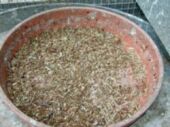Livefood for your Finches So you have been going well with your finches and have bred a number of Stars, Double Bars, Emblemas and Diamond Sparrows. You venture into the bird dealers and lo and behold there is a beautiful pair of Rufous-backed Mannikins and a pair of Melbas. You must have them and so off you go with them to introduce into your aviary - after their customary 40 days of quarantine of course! All is going well and both pairs go to nest, "A breeze this finch breeding" you foolishly think to yourself! A few weeks later you find a number of small black bodies dotted around the floor of your aviary. It is now that the serious fincho must consider adding some livefeed into the diet of their charges. Now, if you are fortunate to live on the 'mainland' you will, probably, have access to the termite or whiteant which can make your job relatively easy. However, if you are not so lucky you may have to settle for the joyous task of culturing maggots or 'gentles', as they are known in more 'refined' circles. As a youth I can remember the elaborate sheep-head drums that we used to maintain in order to obtain a supply of maggots, well out of nasal range and hidden from the parents in the far reaches of their property. This method usually resulted in a feast or a famine - you had thousands of maggots or you had none! Often these maggots would be large and very popular with weavers but of limited use to waxbills. These were in the 'old days' of maggot culture when a demented few threw caution and their sense of smell to the wind - this method of maggot culture was definitely NOT to be recommended after any sessions of alcoholic indulgences!! I may have my history a little astray here so please forgive me but this is how "things" unfolded in Tasmania. Whilst working at the University I was asked to help culture flies for a number of tree frog species being studied. The flies were the 'little green mainland type' (please excuse the vivid description!!) and were cultured on liver in old humidy cribs left over from the pediatrics ward. The flies were plentiful but they were VERY sensitive to the cold and we frequently lost large batches during power failures or through human error. I believe another local finch breeder was experimenting with these flies too and found that he could not maintain a regular supply. He, apparently, experienced large peaks and troughs with these mainland flies.
I then heard of a breeder that had two mobile fly boxes that contained the local 'small pesky black house fly' and heard a couple laughing over his attempts to breed these guys. As luck would have it I was approached by this 'fly pioneer' to 'baby sit' his two prized boxes while he was on holiday. The day for the collection of the boxes came round and he deposited these into my bird room. My god what a noise! The boxes were literally alive with angry black flies! The amount of maggots that were produced from this system was, to me at least, unbelievable. Following discussions with several finch breeders these flies found their way to all corners of Tasmania, and even further I believe. To Roger Curren the Tasmanian finch fraternity owes a huge debt of thanks. It was about this time that I began to read some of the articles from Craig Smeelie about his fly breeding and we were able to fine tune our system. The flies are maintained on a diet of sugar cubes and water and are given
trays of pollard and calf-rearing powder to lay their eggs in. At present a
couple of breeders are trialing a different powder as a food source but the
jury is not yet in on their findings as yet! It has been noted by a number
of breeders that some youngsters leave the nest with a bad case of the
scours and this is being blamed on the cultured maggots. I have seen this in
Blue-caps on one occasion. The good thing about the maggots cultured in this
manner is that multi-vitamin powder and other supplements can be given to
the flies just before they are fed to the birds. Our experiments with Whey
powder have been encouraging and we are now using this instead of other milk
powder products.
I guess it is no real alternative to termites for a lot of you but when you don't have access to them you try what you can. The risk of disease from internal parasites must be reduced by this 'closed system' approach to livefeed but care, and common sense, must be exercised when checking for fungal and bacterial pathogens. Oh, and for all you doubting Thomas's out there, my system was given the thumbs up by a parasitologist who declared it to be not at risk for the spreading of diseases - so there! Do yourself a favour and get into maggots it's a great 'talking point' amongst non-finch people!! However, you may have to practice your innocent 'staring at the roof' stance when your neighbours start to complain about "How many little black house flies there are around this year". What, me? Never!! Written by Marcus Pollard - Copyright remains with the author. |



